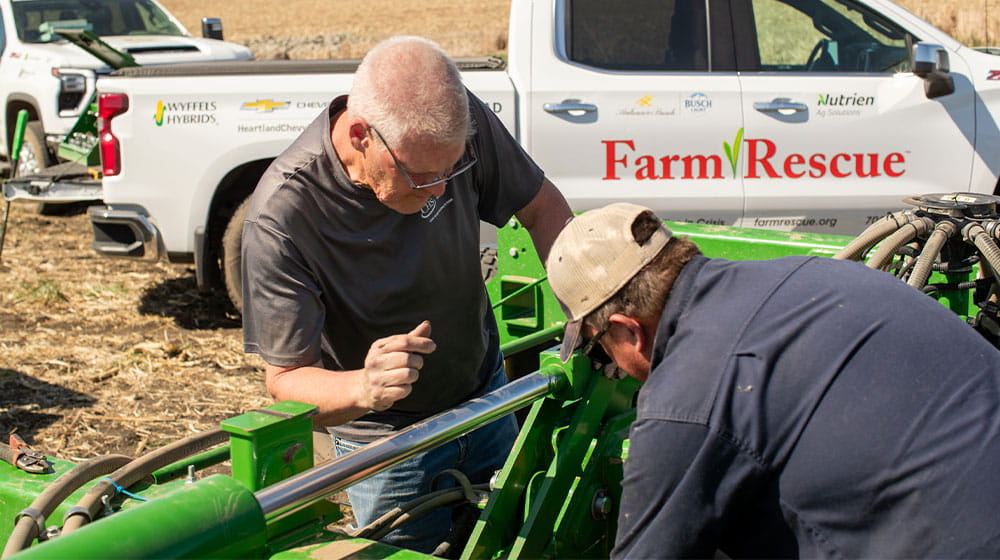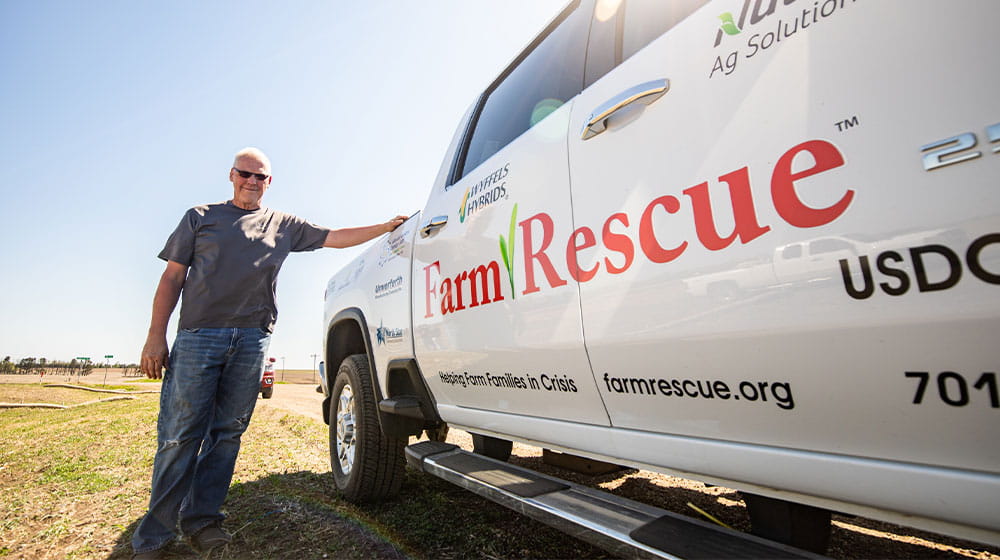The first day of 2025 soybean planting didn’t go as planned for Jim Engelhart on his Venturia, N.D., farm. Still, his daughter Allison couldn’t help but smile as she watched her father, who’s battling cancer, climb over a 60-foot air seeder like he was a teenager.
“He has a spring back in his step,” the 19-year-old exclaimed as her dad, who recently finished a round of chemotherapy, eagerly jumped in to help Farm Rescue volunteers fix the implement. The nonprofit organization, based in Horace, N.D., provides free planting, harvesting, haying and other assistance to farmers and ranchers in need.
Farm Rescue Aid in 2024
- 102 farm families helped
- 26,926 acres planted or harvested
- 4,343 round bales of hay made
- 16,000 volunteer hours
Source: Farm Rescue
The Farm Rescue team and the Engelharts faced plenty of obstacles in their drive to get soybeans planted. First, a wire got tangled in a wheel. Then several broken bolts on a wing had to be replaced to prevent frame damage. An electrical problem kept seeding data from being sent to the tractor monitor and operator. And extreme heat – 95 degrees Fahrenheit in mid-May – and 40-miles-per-hour wind gusts made for a challenging environment.
Despite the challenges, it was a much-needed good day for Engelhart, who is still grieving the death of his wife, Terra, in December 2024 and adjusting to being a single parent.
“Dad needed this,” says Allison. It was the first time in nearly 40 years that the elder Engelhart hadn’t personally planted every acre on the farm.
It took Farm Rescue volunteers three days to seed 1,000 acres of soybeans for Engelhart. He was able to plant about 1,000 acres of spring wheat and corn this spring, but with a family – Jillian, 15; Allison and Tiffany, 25 – and health issues to deal with, Engelhart needed help.
“It’s been a long couple of years,” says Engelhart, a CHS owner and fourth-generation farmer, as he wiped away tears. “We’re all very grateful [to Farm Rescue]. I didn’t have to worry about getting the crop in on time this year, which will help preserve the farm for future generations.”
Allison, a sophomore at Bismarck State University studying ag business and agronomy, aspires to take over the family farm. She’s spending the summer of 2025 as an agronomy intern with CHS River Plains’ Ashley, N.D., location.
“I grew up in a tractor,” she says. “It’s what I want to do for the rest of my life.”

Jim Engelhart, left, helps Farm Rescue volunteer Wade Peterson, Baraboo, Wis., replace a broken bolt on an air seeder.
Answering the call
As Engelhart helped with repairs, he got a call from Jillian reminding him about her school awards banquet that night. “Don’t worry, I’ll be there,” he answers, knowing planting will continue.
That promise, in part, is the reason Farm Rescue exists, says Executive Director Tim Sullivan. The organization provides manpower and equipment to keep farms and ranches running as families deal with death, illness, injury or natural disaster.
“When someone can’t plant or harvest a crop or feed their animals, it can be devastating to their livelihood,” Sullivan says. “We are dedicated to protecting that.”
Bill Gross, a North Dakota farm kid turned UPS pilot, founded the organization 20 years ago to fill a need in his state. Farm Rescue has expanded into eight other states – South Dakota, Montana, Minnesota, Iowa, Nebraska, Wisconsin, Illinois and Kansas – and has helped nearly 1,200 families in crisis.
“Our organization continues to grow with a 10th state [Kentucky] being added soon. Our mission is more important than ever,” Sullivan adds.

Farm Rescue volunteers David Endorf, Daykin, Neb., left, and Drew Fish, Waterloo, Iowa, right, planted corn for Justin Schemm, Wallace, Neb., as he continues to recover from losing his left leg in a farm accident during the 2024 harvest.
Justin Schemm can attest to that. Farm Rescue volunteers planted more than 1,300 acres of dryland corn for the Wallace, Kan., farmer this spring as he recuperates from losing his left leg. Last fall he got it caught in the combine head as he shoveled in spilled corn.
Needing to move every 30 minutes as part of his rehabilitation program, Schemm can’t be in a tractor for long periods. He also can’t handle seed bags until he’s fitted with a prosthetic leg, which is in the works.
“The biggest obstacle is lifting and carrying stuff,” says Schemm, a farmer-owner of CHS United Plains Ag. “The next hurdle is getting in the combine.
“Planting is the most important part of the crop,” he continues, expressing gratitude for the help. “I’ve been extremely pleased with the entire process.”

This 60-foot air seeder and cart helps Farm Rescue cover a lot of acres fast so the organization can assist as many farm families in need as possible.
Worthy cause
Hundreds of donors provide financial and in-kind support to Farm Rescue, which has a $4 million annual budget. Besides staff and operating expenses, the organization buys or leases and maintains a fleet of combines, planters, tractors, semis and pickups.
“It’s not cheap to run our large equipment, buy fuel, and house and feed volunteers,” says Sullivan. “We need big equipment with the latest technology to cover the most acres we can and provide families with confidence the job is getting done right.”
CHS and the CHS Foundation have donated nearly $225,000 to Farm Rescue since 2016. Megan Wolle, senior director of stewardship with CHS and CHS Foundation president, says Farm Rescue embodies cooperative spirit.
“As the nation’s largest farmer-owned co-op, ensuring farm families facing difficult challenges have the support they need is critical to us,” Wolle says. “Our Farm Rescue investments ensure the vibrancy of rural communities and continued success of agriculture.”
For Jim Engelhart, Farm Rescue is a beacon of hope. Seeing the importance of the organization firsthand, he is determined to return to health so he can help fellow farmers in need.
“I’m going to volunteer one day,” he vows. “I want to help out.”
Jennifer Chick contributed to this story.
Jim Engelhart, a CHS owner from Venturia, N.D., is battling cancer. He needed help planting his 2025 soybean crop and Farm Rescue, a nonprofit organization from Horace, N.D. that helps farmers in need, answered the call.
Farm Rescue has assisted more than 1,200 families to keep farms and ranches running since its inception in 2005.
Jim Engelhart, who’s battling cancer, felt good enough after finishing chemotherapy to assist Wade Peterson with repairs on an air seeder.
Though Jim Engelhart needed help with soybean planting this year, he still helped Farm Rescue volunteers repair an air seeder to get the crop in.
Farm Rescue volunteers plant soybeans for Jim Engelhart. In 2024, the organization planted crops for 25 farm families in need.
Drew Fish, left, Waterloo, Iowa, and Justin Schemm, Wallace, Kan., watch David Endorf, Daykin, Neb., plant corn for Schemm in early May 2025 using Schemm’s equipment. Fish and Endorf are Farm Rescue volunteers.
Justin Schemm, adjusts to working on his Kansas farm, which means getting in and out of a tractor, after losing his left leg in a combine accident.
Jeff Preston, Bettendorf, Iowa, a team lead volunteer with Farm Rescue, plants soybeans for Jim Engelhart.
Angels in Blue
Working 12-hour-plus days, getting scraped up wrenching on equipment and spending more than two weeks in farm fields isn’t what most people have in mind for retirement. Not Wade Peterson.
The former utilities superintendent for Baraboo, Wis., volunteers with Farm Rescue, a nonprofit organization that helps farmers in need with free planting, harvesting, haying and other services. In mid-May 2025, Peterson and two other volunteers planted soybeans for Jim Engelhart, a Venturia, N.D., farmer battling cancer.
Peterson says there’s no better way to spend his free time than getting back to his farming roots and helping others.
“It doesn’t take long to get hooked,” he says. “You get to help families that need a hand and meet great people. You can tell it’s hard on the farmers we help that they can’t do all the work themselves.”
Volunteer Glenn Biederman, a John Deere retiree from Louisburg, Kan., adds, “That why we are here – to get people through rough spots and give them time to figure out a path forward.”
Farm Rescue leaders refer to volunteers as “Angels in Blue,” as each dons a dark blue T-shirt sporting the organization’s logo at job sites. Peterson and Biederman’s shirts are stained with grease and covered in ground-in dirt, a testament to the good work getting done.
More than 700 volunteers power Farm Rescue work, according to Executive Director Tim Sullivan. Most volunteers use vacation time to help, are part of company volunteer programs or are retired.
“These unselfish individuals come from every state on their own dime to meet the needs of families in crisis. It’s amazing to see,” he says.
Drew Fish helped plant corn in early May 2025 for Justin Schemm, a Wallace, Kan., farmer who lost his left leg in a combine accident the previous fall. Fish, a factory automation supervisor for John Deere in Waterloo, Iowa, volunteers for two weeks in the spring and fall through the company’s paid volunteer program.
“This has been a way for me to connect with our end user,” Fish says. “People like Justin are what make the volunteering worth it.”
To donate, volunteer or learn more about Farm Rescue.













